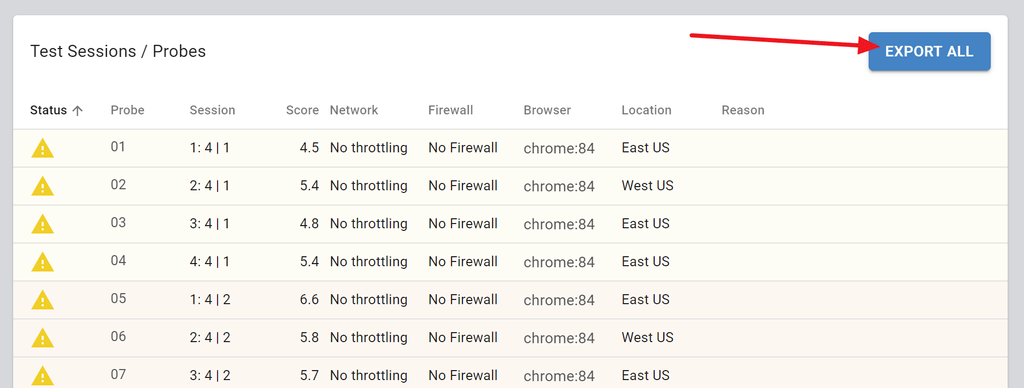When running a large test with many probes, you may want to drill down into the results programmatically or use calculations we don’t offer out of the box. In such cases, you can either use our API to go through the data or use the EXPORT ALL button in the test results page:

Clicking that button will create an download a CSV file that you will be able to open in Excel, Google Sheet or any other spreadsheet tool you want.
The CSV includes the following columns:
- Probe Number – the number of the probe in the test. First probe starts from 1
- Probe Name – the name allocated for the probe in the test
- OS – operating system of the probe
- Media – the media file used for the test in this probe
- Test start time – the starting time of the probe, in UTC
- Test duration – the duration the probe was used in the test, in seconds
- Connection start time – the point in time a connection was first established in the probe, in UTC
- Connection duration – the length of time a connection was on in the probe, in seconds
- callSetupTime – the time it took until a connection was established, in seconds
- score – the media score of the test. See our ranking system for more detail
- sessionNumber – the number of session the probe belonged to
- inSessionIdx – the index of the probe inside the session
- networking – the network configuration used by the probe
- firewall – the firewall configuration used by the probe
- browser – browser and version used by the probe
- location – region the probe was spawned
- status – result of the test on the probe level
- URL – URL of the test results for this probe
- reason – reason given to the status of the probe, relevant in case of warning or failure
- audioBitrate_In – the sum of average bitrate of all incoming audio channels, in Kbps
- audioBitrate_Out – the sum of average bitrate of all outgoing audio channels, in Kbps
- audioBitrate_In_Max – the maximum incoming audio bitrate measured, in Kbps
- audioBitrate_In_Min – the minimum incoming audio bitrate measured, in Kbps
- audioBitrate_Out_Max– the maximum outgoing audio bitrate measured, in Kbps
- audioBitrate_Out_Min– the minimum outgoing audio bitrate measured, in Kbps
- audioPackets_In – number of packets received across all audio channels
- audioPackets_Out – number of packets sent across all audio channels
- audioPacketsLoss_In – the percentage of packet loss on incoming audio channels
- audioPacketsLoss_Out– the percentage of packet loss on outgoing audio channels
- audioJitter_In – average of the jitter on the incoming audio channels, in milliseconds
- audioJitter_In_Max – maximum jitter measured for incoming audio channels, in milliseconds
- audioRoundtrip – average round trip measured across the incoming audio channels, in milliseconds
- audioRoundtrip_Max – maximum round trip measured across the incoming audio channels, in milliseconds
- videoBitrate_In – the sum of average bitrate of all incoming video channels, in Kbps
- videoBitrate_Out – the sum of average bitrate of all outgoing video channels, in Kbps
- videoBitrate_In_Max – the maximum incoming video bitrate measured, in Kbps
- videoBitrate_In_Min – the minimum incoming video bitrate measured, in Kbps
- videoBitrate_Out_Max– the maximum outgoing video bitrate measured, in Kbps
- videoBitrate_Out_Min– the minimum outgoing video bitrate measured, in Kbps
- videoPackets_In – number of packets received across all video channels
- videoPackets_Out – number of packets sent across all video channels
- videoPacketsLoss_In – the percentage of packet loss on incoming video channels
- videoPacketsLoss_Out– the percentage of packet loss on outgoing video channels
- videoJitter_In – not supported in Chrome. Always returns 0
- videoJitter_In_Max – not supported in Chrome. Always returns 0
- videoRoundtrip – average round trip measured across the incoming video channels, in milliseconds
- videoRoundtrip_Max – maximum round trip measured across the incoming video channels, in milliseconds
Note that these metrics are taken from the statistics exposed by the browser. Different browsers measure and expose these metrics differently (and sometimes not at all).
